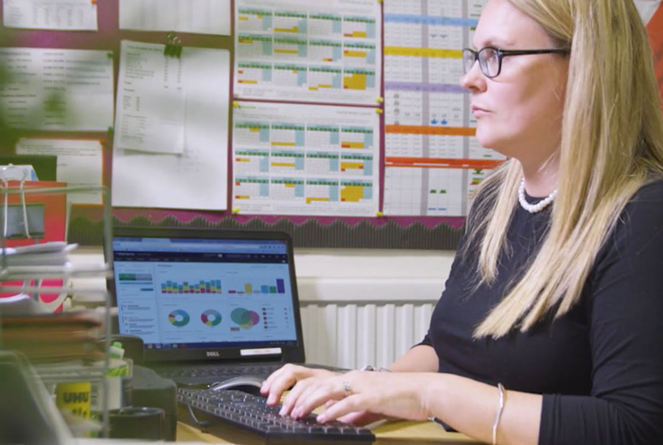Introduction
School leaders know that meaningful feedback needs to be delivered in a way that motivates children to make good progress.
A positive comment or piece of constructive guidance on a child’s work can build confidence, help them develop critical analysis skills and encourage them to reach their learning goals.
But marking and providing feedback can be so time-consuming for your team of teachers, eating into their work life balance and hoovering up precious Child-Time.
We’ve put a few suggestions together to help you implement a marking strategy that is tried and tested by educators to help you banish time-heavy processes and release more time for teachers to do what they do best – teach.
More Child-Time actions
What can I do today?
You may already be thinking about ways to reduce the burden of marking on teachers and find more efficient methods to give children the information they need to make progress in their learning.
One proven strategy that we have seen implemented in schools in a matter of weeks is to replace the labour-intensive task of providing written comments with a scheme that uses symbols which are easy to identify and quick to draw.
These symbols then form the basis of a peer review system which allows pupils to take a central role in feedback, enabling them to develop the skills of their classmates and their own understanding of what progress looks like.
This approach is simple to implement and you could get started today.
Shape a more efficient marking strategy
Ask teaching staff across your school to create a list of the comments they use most frequently when marking children’s work across a range of subjects.
You could take a few minutes to flick through a sample of pupils’ exercise books too, to get a feel for the issues that tend to generate more wordy feedback.
Next, work with staff to create a symbol that can be substituted across the school for each comment or phrase on the list.
| So, instead of…. | Use |
| That’s a really great example |
☺ |
| Try to keep your writing within the margins |
= |
Make sure that the symbols you choose are easy to interpret and quick to draw. Remember the plan is for the children to start using them further down the line.
Once you have a symbol in place for each comment, choose one to start rolling out next term in one subject to keep things simple to begin with.
What shall I work on next term?
Make change happen
Get teachers to talk to their pupils in advance about the new symbol so they know that they will start to see it on their work and understand what it means when they do.
Encourage teachers to engage in more in-class feedback using the symbol too, and to make it clear to pupils what action they are expected to take when they see it in their books.
More symbols can be added one by one over the next few weeks and months as the children become familiar with the new system.
Roll out peer reviewing
Once your school’s new marking and feedback process is more deeply embedded, you can take it a step further to save more Child-Time for teachers.
- Encourage teachers to split pupils into small groups during lessons, asking the children to use the symbols to evaluate their own work and that of their peers.
- Again it is better to start with something simple, such as evaluating handwriting, and give pupils a model of what ‘good’ work looks like to make it easier for them to feedback effectively.
- Ask all pupils to look for the most effective handwriting with their partners so that they become familiar with this process. It is much more manageable for the teacher to check one aspect of feedback than lots at one time.
- Working in twos or threes allows pupils to discuss what good work looks like but a set of ground rules will help these discussions stay focused on what a pupil has done well and where they can improve, rather than veering off on to what is ‘wrong’ with the work. Always ask them to start with the positives first.
- Make sure there is time left during the lesson for pupils to improve the areas identified.
Increase in-lesson feedback
- Now pupils are able to evaluate their work in one area and they know and understand a repertoire of symbols, they will have the skills to take more responsibility for providing feedback for themselves and their peers.
- Part way through each lesson, ask pupils to work in threes to review their work, taking each child’s work in turn. The pupils whose work is looked at first should place their work on top of the others and that pupil should hold the pencil.
- First, pupils should discuss together the most effective parts of the work, then the author should underline this section. Next, pupils should together choose one aspect which could be further improved, using the marking symbols to indicate this. Again, it is only the author who should annotate their work.
- Allow time at the end of each lesson for pupils to work on any areas for improvement to keep them motivated and making progress.
Once children are able to evaluate and improve their work within the lesson, the need for distance-marking decreases and the people who are working hardest on marking are the ones who will benefit from it most – the children.
What shall I be working on for the rest of the year?
Review and improve
- Provide regular opportunities for teaching staff to share new ideas and examples of best practice throughout the year so that you can continue to incorporate more effective feedback within lessons.
- Identify teachers who excel in specific feedback strategies and encourage teachers to visit other classes to see best practice.
- Update your feedback and marking policy to reflect your current practice – you could include photos of pupils’ work to make it clearer for new staff and governors.
- Monitor the impact of new marking practices on workload and teachers’ wellbeing to ensure change is having a positive impact.
Work smarter not harder
Look at the technology and tools you have access to that can help teachers to work more efficiently and effectively to provide valuable feedback to children across your school.
What to consider
- Pupil trackers allow teachers to assess pupils against objectives during lessons.
- Give pupils personalised feedback in a visual format. Many pupil trackers and MIS offer this option.
- Link photos and videos to statements as evidence of pupil attainment.
The advantage
- Avoids ‘double-handling’ of ticking success criteria in exercise books then recording this progress electronically.
- It can be quicker and offers a more visual option than giving feedback and targets to children verbally.
- It’s fun for pupils and eliminates the requirement to write details of what has been observed.
Expected results
Implementing a system of marking symbols and increased use of peer-provided feedback can have a positive impact across your school.
You can save hours of time for teachers and at the same time, support children’s learning and development.
Pupils will build the skills they need to correct careless mistakes and evaluate their own and classmates’ work. But most importantly, help them learn how to take an active role in their own progress.
With feedback integrated into the teaching process, you can reduce the need for detailed distance-marking, ease teachers’ workloads and free up more Child-Time.


/Primary%20school%20.jpg?width=2000&name=Primary%20school%20.jpg)








.png?width=940&height=788&name=Lingfield%20College%20Case%20Study%20(5).png)
-1.png?width=1000&height=833&name=National%20Association%20of%20Head%20Teachers%20(3)-1.png)
-3.png?width=1080&height=1080&name=Untitled%20design%20(10)-3.png)








